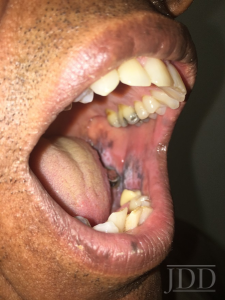
The correct answer is D. Lisinopril is the most likely cause of the discoloration on his left buccal mucosa.
Causes of white and pigmented discoloration on the buccal mucosa include leukoedema, leukoplakia, oral lichen planus, candidiasis, and contact reactions, including amalgam. This patient’s biopsy is consistent with a lichenoid reaction. Multiple eosinophils are indicative of a possible drug-induced lichen planus. Causes of lichenoid drug eruptions include: gold, antimalarials, quinidine, penicillamine, amphetamines, thiazides, ACE inhibitors, TNF-alpha inhibitors, and statins. Drug-induced oral lichen planus is most commonly caused by NSAIDs, sulfonylureas, antimalarials, HIV antiretrovirals, beta-blockers, and ACE inhibitors. Though the oral mucosa is often spared in lichenoid drug reactions compared to lichen planus, oral lichenoid drug reactions may occur with or without skin involvement. Unlike oral lichen planus, drug-induced oral lichen planus is usually unilateral. Drug-induced lichen planus may take many months to develop and weeks-to-months to resolve after stopping the medication, often with long-lasting dyspigmentation.
Schlosser BJ. Lichen planus and lichenoid reactions of the oral mucosa. Dermatol Ther. 2010 May-Jun. 23(3):251-67
